The Best New York Style Pizza Dough and 14 Tips for Success!!
I’ve been making a lot of this NY style pizza dough recipe …. The obsession started a while back, and I’ve finally found a recipe that I love the best! After years of experiments (and I mean years!), I am now using this recipe based on recommendations from the many fine pizza makers at www.pizzamaking.com and the late great Dough Doctor, Tom Lehmann.

Making Pizza Dough at Home
Making NY style pizza dough is definitely somewhat of an art form. There are so many variables that can be changed aside from the ingredients alone. For example, these variables include:
- oven temperature
- temperature of the water used to make the dough
- proofing methods (room temp vs cold rise)
- order of adding the ingredients (yes, this makes a big difference!)
- mixing time
- use of autolyse
- use of poolish (I don’t do this or the one before, although I have in the past)
And then of course, the toppings which can be simple or as complex as you’d like. But don’t worry too much about all of this – my method is easy and straightforward. Plus, you will make better dough than 99% of the pizza chains out there. You will not want take out anymore!
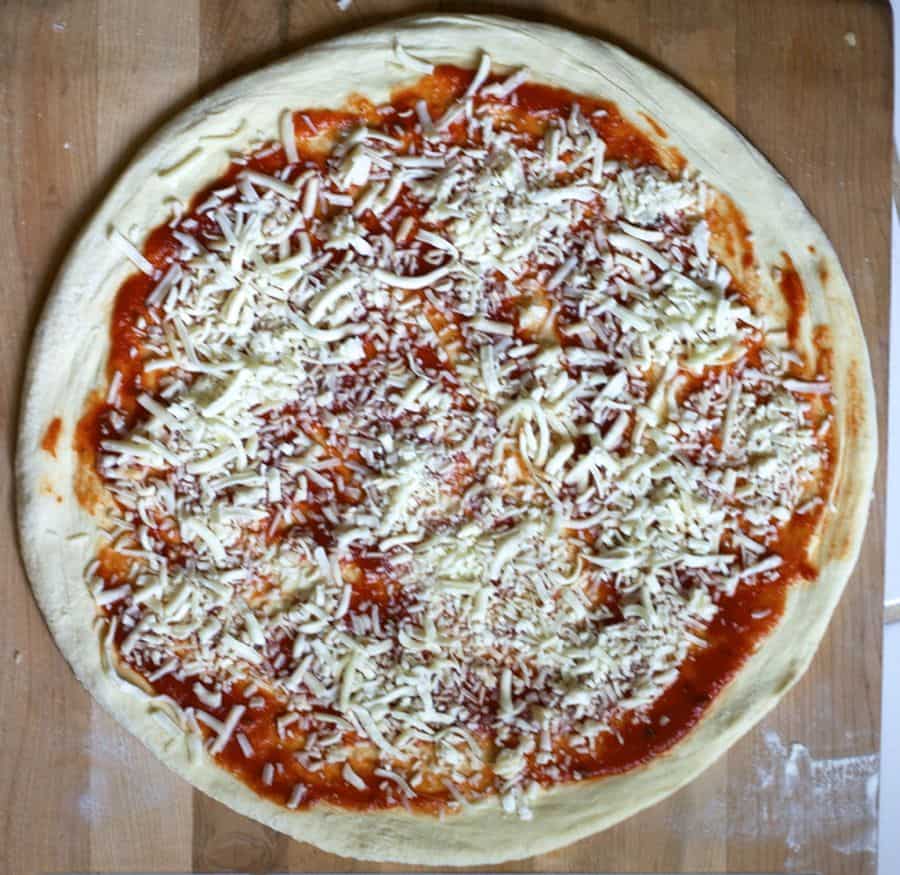
My Favorite Pizza Dough: The Big Secret (How You Proof the Dough)
My all-time favorite dough is NY style dough, which really is classic pizza dough that is stretched out into a thin crust pizza. This type of pizza dough contains water, flour, salt, instant yeast, and olive oil (and sugar especially when baking in a home oven, to help browning).
After it is mixed, it is proofed (left to rise/ferment) in the refrigerator for a minimum of 24 hours and up to 72 hours (it can also be frozen) – this is the big secret. I’ve used the dough up to 5 or 6 days afterwards, so you can essentially prepare dough for the week.
This recipe produces a crisp yet foldable crust that is tender, light, and flavorful and will make enough for four 14-inch pizzas. You can easily double or half the recipe to make 2 or 8 pizzas.

Fourteen Tips for Success
Tip 1: Choosing the flour
Use high-quality flour – I like to use King Arthur’s all purpose or bread flour; higher protein (ie, bread) flours work best. However, I prefer all-purpose flour because I like a lighter, airy crust.
Tip 2: Adding the yeast
Do not add instant dry yeast (IDY) directly to cold or cool water – you may shock the yeast (add the IDY to your flour instead) (please note that IDY differs from active dry yeast, which must be activated by adding it to water).
Tip 3: How much yeast?
Use only enough yeast to “get the job done” – yeast eats the sugar in your flour to produce its leavening effects – I find that if you use too much, your dough will be tasteless (this is just my opinion); however, it is a fact, that too much yeast can make your dough taste bad. Most recipes out there, some of them in well known, published books contain too much yeast!
Tip 4: Cold ferment that pizza dough!
Always use your refrigerator. The best NY style doughs “ferment” or “cure” in the refrigerator for at least 24 hours and up to 48 72 hours. This is called a “cold rise” (vs warm rise on your kitchen counter).
The refrigerator is used to retard (or slow) the dough’s fermentation, allowing that distinctive flavor to come through (ever wonder why some pizza crust tastes different than others, despite the fact that they are both made from just about the same exact ingredients? – this is a big reason why!)
When your dough rises too quickly, the flavor will not develop optimally. Slow rise = MUCH better flavor.
Tip 5: Weigh those ingredients!
Use a scale to weigh the flour instead of using a measuring cup – it is much more accurate and will yield superior results. I’ll admit, I resisted doing this for a loooong time. Just do it. You’ll be glad you did and your dough will be more consistent and much improved.
Tip 6: Add oil last
Mix the oil in as the last step, after the flour has all been incorporated. This is important to allow the flour to hydrate properly.
Tip 7: Flour your dough balls
Before tossing or opening your dough balls, flour them *very* well on each side (if you are a beginner) to ensure they do not stick to your counter or pizza peel. I sometimes use a bit more flour after I begin spreading them.
Tip 8: Keeping those rims a bit puffy
Take care not to “degas” the rim of your pizza as you are spreading your dough! Do NOT ever use a rolling pin! There are many different methods to spread/open your dough ball. I hope to add a few pictures someday of this process.
Tip 9: Baking pizza in a home oven
Ensure that your oven is preheated for a sufficient amount of time (about 1 hour) and bake the pizza within 6 to 8 inches of the top of your oven (ie, your broiler) so that the tops browns sufficiently in conjunction with the bottom of the pizza.
Do not place the stone near the bottom of your oven. I made this mistake for too many years.
After your stone has been preheated sufficiently, the heat from the stone will cook the pizza from the bottom and you can switch the broiler on if you find you need more browning on the top (I now use the broiler to bake my pizzas…more on this sometime in the future).
If you find that your cheese is browning well before your rim attains sufficient color, use partially frozen cheese (ie, place shredded cheese in the freezer while the oven is heating up) and cold sauce or you can drizzle just a bit of olive oil on top of cheese.
Tip 10: Use a pizza stone or steel
Use a pizza stone if you have one. The stone with draw moisture out of the dough and produce a beautifully crisp crust. I use a pizza steel because my stones kept breaking.
Tip 11: Use just the right amount of sauce
Do not use too much pizza sauce – it will make your pizza soggy
Tip 12: Find the right kind of cheese
Do not use low fat cheese to top your pizza or pre-shredded cheese (the former will not melt sufficiently and the latter contains additives that prevent the cheese from sticking together and therefore does not melt very well). The best is low-moisture, whole milk mozzarella.
If you must use pre-shredded cheese, I’ve found that adding the sauce on top of the cheese helps with the melting. Also, do not use too much cheese; apply it sparingly so that you can achieve that mottled NY pizza appearance.
Tip 13: Flour your pizza peel
Use semolina or flour on the bottom of your pizza peel to prevent the pizza dough from sticking but be careful not to overdo it because it will burn.
Tip 14: Learn to launch that pizza
Give the pizza peel a few very small quick jerks to make sure the pizza will easily slide off your pizza peel before attempting to transfer pizza to the oven, and more importantly, rub flour into the peel before placing the dough on top.
Essential Equipment
Please note that as an Amazon affiliate, we earn a small commission if you purchase a product at no additional cost to you.
I adore my baking steel; it’s transformed my home pizzas into restaurant-quality and better. You will love this! A kitchen scale streamlines measurement with remarkable accuracy, while a pizza peel is essential for smoothly sliding pizzas into the oven. And proofing boxes provide an optimal storage for pizza dough fermentation, enhancing flavor, texture, and elasticity.
Please visit our SHOP page for more recommended tools and equipment to make restaurant-style NY-style pizza at home!
How to Stretch the Pizza Dough
A nice video (from The GoodFellas Pizza School of NY), showing how to stretch the dough:

How to Freeze Homemade Pizza Dough
- After mixing dough and dividing into balls, place dough in refrigerator for at least 24 hours.
- Place dough balls on baking sheet lined with plastic wrap or parchment paper, cover loosely with plastic wrap and freeze until firm (~ 2 to 3 hours or up to overnight).
- Wrap frozen dough balls individually in plastic and store in zipper-lock bags for up to 4 weeks.
- When ready to bake, transfer unwrapped dough into the refrigerator for 12 to 24 hours before making pizza.
- Bring dough to room temperature for 20 to 60 minutes before baking (less time for hot kitchen/summer and more time for cool kitchen)
Pizza Dough Calculator
Need more dough? Less dough? Try out our new Pizza Dough Calculator to calculate the weights to get it just right!
Have More Questions?
Please See My NY Pizza FAQ
If you tried this recipe, please leave a 🌟 star rating and let me know how it went in the 📝 comments below! SUBSCRIBE for more recipes.
📖 Recipe

The Best New York Style Pizza Dough
Equipment
- pizza stone or pizza steel for baking
- Standing mixer optional or hand knead
- kitchen scale highly recommended instead of volume measures
Ingredients
Original Recipe for Four 14-Inch Pizzas; want to make more or less? Use the pizza dough calculator
- 6.5 cups (796 g) all purpose flour or bread flour (weighing is most accurate!)
- 2 1/4 cups (493 g) water barely cold water (17.4 oz per 2 1/4 cups)
- 1 teaspoon (3.5 g) instant dry yeast
- 2.5 teaspoons (15.6 g) salt
- 2 teaspoons (7.8 g) sugar
- 1 tablespoon (11.8 g) olive oil
1 Pound of Dough (~454 grams) (use the pizza dough calculator to make more or less dough)
- 2 1/4 cups (274.5 g) all purpose flour or bread flour
- 3/4 cup (170.2 g) water
- 1/2 teaspoon instant dry yeast
- 1 teaspoon salt
- 3/4 teaspoon sugar
- 1 teaspoon olive oil
Instructions
Mixing the Dough
- Place water in mixing bowl.
- In a separate bowl, mix salt and yeast (and sugar if using) into flour
- Combine flour/salt/yeast mixture into water and mix until all the flour has been incorporated.
- After flour has been totally incorporated, add oil and knead for about 4 to 5 minutes (see note)
- Test final dough temperature, which should ideally be between high 70s to low 80s (optional)
Dividing and Rising
- Divide dough into 4 equal pieces (using a digital scale if possible; each ball should weigh 11.5 oz [~326 grams]), shape into a ball, and place in greased, sealed quart-sized container or oiled/greased freezer bag and refrigerate overnight or up to 72 hours (After much experimenting, I have concluded that I like 3 days best but day 2 is good too).
Assembly and Baking
- The following day, remove your dough balls within 1 hour or less of baking and allow the dough to come to room temperature. (the dough will tend to blister more if the dough has not been allowed to come to room temperature however, I often bake coldish dough without problems, just some bubbling)
- In the meantime, place your pizza stone in oven and preheat at 550 degrees (depending on thickness of your stone and your oven’s power) for at least 1 hour
- Open each dough ball using care not to degas, transfer to a pre-floured pizza peel (or on parchment paper), and top with your favorite sauce, cheese, or other toppings.
- Transfer pizza from peel to oven or slide parchment paper onto preheated pizza pan/stone and bake for 4 to 6 minutes each until browned on top and cheese has melted but not burned.
- Enjoy!
Notes
- Use of weight based measurements is highly recommended instead of US Customary. You will need a kitchen scale.
- METRIC amounts DO NOT correspond exactly to the US Customary amounts because, for example, 796 grams equals 6.4 cups (and most can’t measure 0.4 cups or 0.22 cups). Recipe was based on grams.
- Use the Pizza Dough Calculator
- If you want to use the dough the next day, knead a little more (slow speed for about 8 to 10 minutes)
- If you have time to let the dough rest for 3 days, knead for 4 to 5 minutes, low speed or hand knead.
- After mixing dough and dividing into balls, place dough in refrigerator for at least 24 hours.
- Then, place on baking sheet lined with plastic wrap or parchment paper, cover loosely with plastic wrap and freeze until firm (~ 2 to 3 hours or up to overnight).
- Wrap frozen dough balls individually in plastic and store in zipper-lock bags to store for up to 4 weeks (longer may work, but results might vary).
- Before using, transfer unwrapped dough into the refrigerator for 12 to 24 hours before making pizza.
- Bring dough to room temperature for 20 to 60 minutes before baking (less time for hot kitchen/summer and more time for cool kitchen).
- calculate your own using baker’s percentages: 62% hydration, 0.4% yeast, 2% salt, 1.5% oil, and 1% sugar or use my new pizza dough calculator.
Nutrition
Try these other pizzas and this NY pizza sauce:
Buffalo style (one of my absolute favorites)
White with prosciutto
White with spinach and feta
Pizza sauce

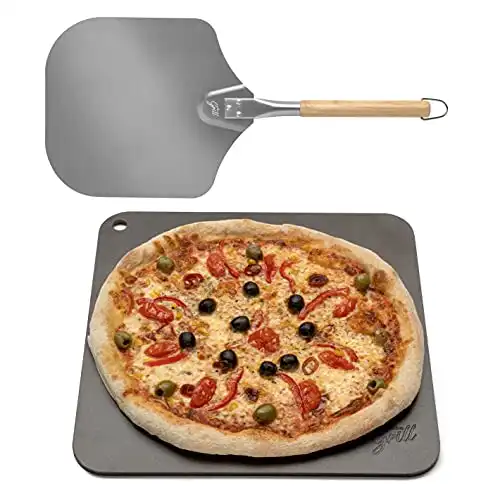
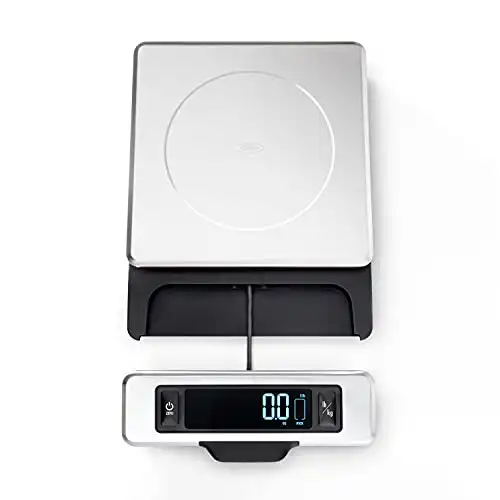
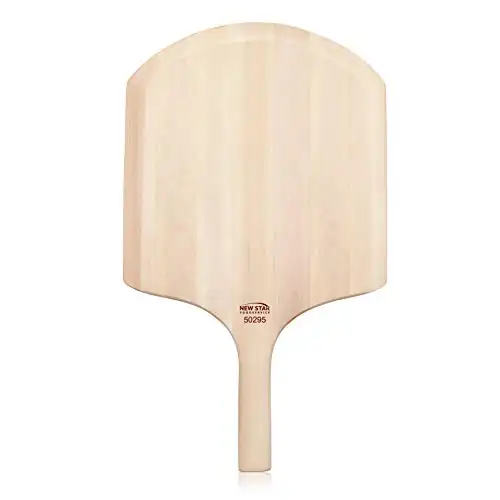
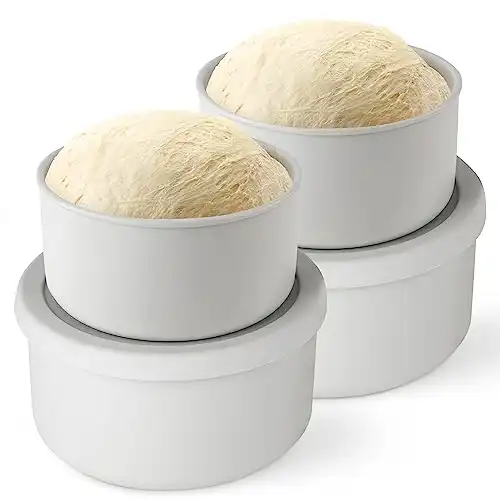
This turned out perfect for us, great tasting recipe. thanks.
Simon
This is my 6th time making this dough and I get better at it every time thanks to your tips! The best one… use a scale instead of measuring ingredients. What a difference that makes! The first time I made this dough, I didn’t have a scale so I measured. The dough was difficult to manage and the finished product was just okay. So I bought a scale and tried again. What a difference!
I love how you explained the chemistry of this recipe and the difference in how yeast behaves using the cold rise method. This was all new to me even though I’ve been making bread for years.
Since I’ve been enjoying this recipe for a year now, I thought I’d drop back by and leave you a note of thanks for this post … you detailed the method splendidly for the best crust I’ve ever made at home! THANK YOU!
yes, the scale and the cold rise do make a big difference – agreed!
I might be asking a question that has already been answered, but I did my best to try to search for the answer in earlier threads. As you instructed, I’m doing the cold rise. I’m on day 1 and I plan to do a 2 day cold rise. How much is the dough supposed to rise? It’s been 24 hours and the dough is slightly bigger. I did follow the instructions correctly (I believe :-)) and used brand new instant yeast. After 2 days, is the dough supposed to be doubled in size or that doesn’t really happen with a cold rise?
One last question. I’ll be storing the extra dough in the freezer, but do I store the dough after the cold rise for a couple days or should I have stored the extra dough in the freezer immediately after I finished mixing all the dough (before the cold rise)?
The dough will not double in size, but you will notice that it has some bubbling. And about freezing, I’ve done it both ways. Sometimes, I don’t end up using all the dough so I place it in the freezer and other times, I’ll do it right after mixing. I haven’t noticed that much of a difference but then again, I’ve never done a direct comparison – both seem fine to me. I will place the frozen dough in the refrigerator to defrost the morning that I want to use it.
First things first, the pizza dough came out great. I also used your pizza sauce recipe and it was amazing. As a native “New Yawker”, it took me back home. I couldn’t find a pizza stone, so I used the only think I could find at the store which was a hot plate. I don’t think it was able to get hot enough, so the bottom wasn’t as crisp as I would have liked. However, I’m ordering the pizza stone online, and I’ll have it the next time I make the pizza.
Marie, you should be given an award for the longest social media commentator in history. I didn’t realize this recipe has been up since 2012 and you’ve been engaged the entire time. Many kudos and thanks to you for putting in all this effort. Thanks again, you are a gem for sharing this recipe (and answering our questions). You are amazing!
haha – it has been a while, hasn’t it!?
Awesome recipe, great video! Hilarious to see the guy in the background putting his fly swatter to good use…
I just made your pizza dough recipe last night. Although I normally shy away from seemingly “simpler” recipes, this one was one of the best that I’ve ever made! We made two pies last night: one just sauce (your sauce) and mozzarella and a buffalo chicken. Both crusts were fantastic, although I need to let the stone heat up for a while longer because the second pie cooked better. Thanks for your help with my quest to make the best home pizza!
Your directions states “Transfer pizza from peel to oven or slide parchment paper onto preheated pizza pan/stone ” Do you leave the pizza on the parchment paper and place the pizza (and parchment paper) on the pizza stone to bake, or do you slide the pizza off of the parchment paper onto the pizza stone?
Hi, you slide the parchment with the pizza on it, onto the pizza stone.
Hi,
I’m new to pizza making but love this recipe! I don’t have anything fancy to bake the pizza on but have worked out how to get it crispy underneath due to your other suggestions. I am using active dry yeast and have purchased but not tried pizza dough yeast. My dough doesn’t get the little holes underneath, like you state and what I know I should be seeing due to bread I bake. I’m wondering if I should try activating the yeast first, even though it’s not in your recipe, or should leave it out of the fridge to rise instead of cold rising. The dough still tastes great and I’ve made it a few times now. I love the video you listed and have tried stretching my dough that way. It seems to work ok but my dough tends to get too thin in places and pulls apart. I’m wondering if this has to do with the yeast not activating right. I’ve tried to stretch it cold from the fridge, 1,2 and 3 days after being left in the fridge. Also, after having been sitting out to warm to room temp. I’ve used lots of flour and barely any but still can’t get my dough to act or look as beautiful as your pictures…still delish though and will continue to be made! Any thoughts or suggestions would be great! Thanks so much!
Hi Alyssa – do you mean that the dough tears when you stretch it? If yes, then try kneading it for a longer period of time to develop the gluten more. Also, what kind of flour are you using? Make sure it’s at least 11% to 12% protein (some All purpose flours like King Arthur and Gold Medal). Some even like 13% (bread flour). The presence or absence of bubbles would not make a difference in dough tearing, but if you’d like to try a warm rise (room temp), I wouldn’t do more than 1 hour after taking out of fridge. I still like the cold rise because it imparts good flavor.
Hi, I’ve just finished reading “The Pizza Bible”. Experimenting with different styles of pizza. Made some deep dish pizzas that came out great. I found your recipe and it looks like a real winner. My question is the amount of dough used for a 14 inch pizza equals about 332 grams per pizza.Are my calculations correct? Seems like a ultra thin pizza. I love the recipe and look forward to trying it. Thank you very much.
Hi Steven – I have his book too – it’s great! Good question about the dough weight – yes, it is very “old school” traditional thin. I would suggest that you do a 12 inch if you’d rather have the more common thin crust pizza that is popular these days. Or, if you want to customize a little more, access my FAQ tab and you can see how to easily calculate how much dough you will need for any size pizza.
Do you use a hand mixer to mix the ingredients in step 3?
I usually use a stand mixer
New to baking and attempted my first pizza crust yesterday. What a disappointment! It tasted just like Australian Damper Bread and was an inch thick. I grew up in New York and miss real pizza! One question, please. I can’t afford a heavier steel sheet right now. I have a stainless pizza pan and a cast-iron skillet. Any idea which is the better option for me?
Hi Jack – you can try either really. I’d maybe try preheating either one, then stretching the dough and placing it on parchment paper and sliding it on the pan or skillet when it is good and hot. What recipe did you use for the pizza that was an inch thick and what kind of flour? The flour will be very important to get good results.
House of Yumm no-yeast pizza dough recipe. The thickness was my fault probably for not cutting the dough in half and not making the pizza base properly. It was fun to make, but it didn’t have that NY style taste. I used an all-purpose unbleached flour, Bob’s Red Mill.
Just watched the video you included — it’s brilliant! I’m going to try again with the yeast tomorrow and will let you know later in the week how it all came out. Thanks for getting back to me about the pizza pan situation.
Just finished eating my pizza! The dough was fun to make and even more fun to stretch! That video is brilliant! I watched it a few times and took notes to bring into the kitchen. What a rush to actually pick up the dough in the last step and stretch it out to its final shape! My pan is not 14 inches but 10, so had to make adjustments, and the bottom of the pie was somewhat crispy but wasn’t cooked quite as much as it could be, most likely because the preheated pan cooled quickly while I was adding the toppings. Crust was delicious and the slices folded quite nicely.
Until I can get a baking sheet or stone, is it possible to put the pan with the dough on it in the oven for a minute to get a start on the bottom and then add cheese, sauce, etc?
I’m resisting going back in and grabbing another slice! Thanks for a brilliant recipe. You’ve made this former New Yorker very happy indeed!
Excellent recipe! First attempt came out really well. I didn’t achieve the foldable base but the crust was delicious and full of flavour ! Thank you
Forgot. You’re one of the few people blogging online that really seems to know what she’s doing as far as making pizza goes. I say that because i have spent a lot of tme figuring out how to make pizza. Good job.
KA flour is ok but All Trumps flour is what I like. You can’t buy it in a grocery store. You have to buy it online. I agree that 3 days doing a cold proof is best. I’ve found after that the pizza dough begins to degrade in quality. I also agree using a carbon steel plate to bake the pizza on is best. Pizza stones can’t get that hot. I never add my salt until after the dough is being kneaded in my mixer ie after the flour yeast and water are thoroughly combined. You were talking about the ingredients order. Please clarify.
Hi Mark – I’ve never used All Trumps but I have used Kryol and Occident which are I think 14% and ~11% protein, respectively – so maybe the Kryol is comparable to the All Trumps? And from what I remember they are all bromated? The Occident was good but not superior enough to KA AP in my opinion to be eating potassium bromate (you know this debate/argument I”m sure). And since I prefer a more delicate yet crispy crust I did not like the Kryol (I guess this is just personal taste?). With regard to salt, when I hold it back, sometimes my dough is wayyyy too extensible but I’m using flour with a lower protein content so that is most likely the difference here. I do recommended to hold back the salt if someone writes and says that their dough is too elastic so it’s just a matter of altering things to suit your situation.
This is a great recipe Marie. In specific, I like that you recommend less yeast and a longer fermentation time. With respect to flours, high gluten flours like All Trumps, Kyrol and Power are very popular for New York Style pizzerias.
The All Trumps and Kyrol have a similar protein percentage, but the All Trumps is far more popular. In many states, bromated flour is illegal, so a non-bromated version (http://store.thepizzabible.com/products/all-trumps) is also available.
In addition to your tip re. salt, I’ve also found that dough which tends to be elastic gets more slack (and workable) as it ferments more. I usually like to let my New York style doughs rise for 24-48 hours.
Hi Raj – thanks for the tips! I’ve tried Kryol and I liked it, but I wanted to provide options for folks who don’t want to special order or those who don’t live near stores that carry it. My local farmers market carries Kyrol and Occident (which I’ve found has too high of a protein content). I recall lots of gyus on the pizzamakign.com board who really loooooved All Trumps. I think I have tried the 24 and 48 hours in the past – will try again sometime soon. Lately, I’ve been using mostly Caputo 00 flour with my Blackstone oven – Neopolitan style. Same day dough but ferments all day. Very low yeast percentage, and only 52% hydration. It’s SO good! 🙂 I love NY style too but it’s good to mix it up sometimes, right?
I tried this recipe and weighed everything. The dough seemed dry while mixing. added a bit more water but was afraid to go off trail since I am not a bread maker. When I pulled the dough to stretch out for the pizza it was really difficult to work with. What could I have done wrong? Thanks in advance from a cooking novice!
Hi Suzi – that’s hard to say. If it was too hard to stretch, definitely add maybe a tablespoon or more of water next time and you can also hold back the salt until the dough is mixed then add it, to get more stretch. If you have access to an all purpose flour like Gold Medal or King Arthur, that’s also something you can try instead of adding more water or holding back salt (you may have been using a flour with a very high protein content, which calls for more water) – hope it works out better for you next time.
Wow wow WOW
I have tried every technique, every recipe but this… I am blown away. It was so similar to every other pizza dough but it’s different somehow. Maybe it’s when the oil was added or maybe I handled the dough differently after reading your comments… Having felt the end product dough, I knew it was a winner, I just knew lol
If anyone is wondering “should I or shouldn’t I” … Just do it!!! It is better than you can imagine … I can still taste it
Thank you so so much for sharing this 🙂
All the way from Ireland, go raibh mile maith agat – a thousand thankyous 😀
Btw, I’ve never rated any recipe before lol
It’s funny how small changes can make differences! Thanks for your kind comments and glad to hear you enjoyed it.
Hi! I love the taste of this pizza dough. I have made it twice and have had the same issue bit times. The pizza dough doesn’t stretch well. I thought that maybe the dough was too cold so this time I let the dough sit out for a couple hours to get up to room temp. I even checked the temp and it was at 70. I weighed all of the ingredients (everything was perfect), put it in the fridge for a little over 24 hours. I can’t figure out what I’m doing wrong. Any ideas?
Matt
Hi Matt – it’s hard to say but one thing that you can do it add the salt last after everything else and after the dough has been mixing for a few minutes to give the gluten a head start – see if that helps? You may also add a tablespoon or 2 of water and that might help too. I’d try the salt strategy first. Good luck